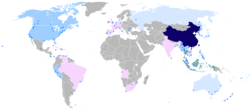
Back Акитаи бызшәа Abkhazian Bahsa Cina ACE Chinees Afrikaans Chinesische Sprachen ALS ቻይንኛ Amharic Kuwaping a sowal AMI Idioma chinés AN मानक मंदारिन ANP اللغة الصينية Arabic ܠܫܢܐ ܨܝܢܝܐ ARC
| Chinese | |
|---|---|
| 汉语/漢語,华语/華語 or 中文 Hànyǔ, Huáyǔ or Zhōngwén | |
 Hànyǔ (Chinese) written in Hanzi | |
| Native to | People's Republic of China (PRC, commonly known as China), Republic of China (ROC, commonly known as Taiwan), Canada, Peru, Thailand, Vietnam, Malaysia, Brunei, Singapore, Indonesia, Mauritius, Australia, the United States, the Philippines and other places with Chinese communities |
Native speakers | (1.2 billion cited 1984–2000)[1] |
Sino-Tibetan
| |
Standard forms | |
| Dialects |
|
| Chinese characters, zhuyin fuhao, pinyin, Xiao'erjing | |
| Official status | |
Official language in |
|
Recognised minority language in | |
| Regulated by | In the PRC: National Commission on Language and Script Work[2] In the ROC: National Languages Committee In Singapore: Promote Mandarin Council/Speak Mandarin Campaign[3] |
| Language codes | |
| ISO 639-1 | zh |
| ISO 639-2 | chi (B) zho (T) |
| ISO 639-3 | zho – inclusive codeIndividual codes: cdo – Min Dongcjy – Jinyucmn – Mandarincpx – Pu Xianczh – Huizhouczo – Min Zhonggan – Ganhak – Hakkahsn – Xiangmnp – Min Beinan – Min Nanwuu – Wuyue – Yueoch – Old Chineseltc – Late Middle Chineselzh – Classical Chinese |
| Linguasphere | 79-AAA |
 Map of the Sinophone world. Information: Countries identified Chinese as a primary, administrative or native language
Countries with more than 5,000,000 Chinese speakers
Countries with more than 1,000,000 Chinese speakers
Countries with more than 500,000 Chinese speakers
Countries with more than 100,000 Chinese speakers
Major Chinese speaking settlements | |
| Chinese languages (Spoken) | |||||||||||||||||||||||||||||||||||
| Traditional Chinese | 漢語 | ||||||||||||||||||||||||||||||||||
|---|---|---|---|---|---|---|---|---|---|---|---|---|---|---|---|---|---|---|---|---|---|---|---|---|---|---|---|---|---|---|---|---|---|---|---|
| Simplified Chinese | 汉语 | ||||||||||||||||||||||||||||||||||
| Literal meaning | Han language | ||||||||||||||||||||||||||||||||||
| |||||||||||||||||||||||||||||||||||
| Chinese language (Written) | |||||||||||||||||||||||||||||||||||
| Chinese | 中文 | ||||||||||||||||||||||||||||||||||
|---|---|---|---|---|---|---|---|---|---|---|---|---|---|---|---|---|---|---|---|---|---|---|---|---|---|---|---|---|---|---|---|---|---|---|---|
| Literal meaning | Chinese text | ||||||||||||||||||||||||||||||||||
| |||||||||||||||||||||||||||||||||||
The Chinese language is the group of languages used by Chinese people in China and elsewhere. It forms part of a language family called the Sino-Tibetan family of languages.
Chinese includes many regional language varieties, the main ones being Mandarin, Wu, Yue and Min. These are not mutually intelligible[4] and many of the regional varieties are themselves a number of non-mutually-intelligible subvarieties.[5] As a result, many linguists refer to these varieties as separate languages.[6]
'Chinese' can refer to the written or the spoken languages. Although there are many spoken Chinese languages, they use the same writing system.[7] Differences in speaking are reflected in differences in writing. Official China has a similar policy to the one in the Soviet Union: one official language is used so people can understand each other. The Standard Chinese language is referred to as Mandarin in English, "Pǔtōnghuà" or "common to everybody speech" in mainland China and "Guóyǔ" or "language of the whole country" in Taiwan. All official documents in Pinyin are written in Mandarin and Mandarin is taught all over China. It is also a standard for language teaching in some other countries.
Chinese is used by the Han people in China and other ethnic groups in China who are declared Chinese by the Chinese government. Many people in autonomous regions of China speak other languages. Chinese is almost always written in Chinese characters. They are symbols that have meaning, called logograms. They also give some indication of pronunciation, but the same character can get very different pronunciations among the different kinds of Chinese. Since Chinese characters have been around for at least 3500 years, people in places far from each other say them differently, just as "1, 2, 3" can be read differently in different languages.
Chinese people needed to write down pronunciations in dictionaries. Chinese does not have an alphabet, so how to write down sounds was a big problem in the beginning. Nowadays, the Mandarin language uses Hanyu Pinyin to represent the sounds in Roman letters.
All the Chinese languages (or dialects) use tones. This means that they use high and low pitches to help make differences in meaning clear.
- ↑ Chinese language at Ethnologue (16th ed., 2009)
- ↑ china-language.gov.cn Archived 2015-12-18 at the Wayback Machine (in Chinese)
- ↑ "Speak Mandarin Campaign". Retrieved 2011-08-09.
- ↑ This means a speaker from one region cannot understand a speaker from another region, unless they have also learnt that language.
- ↑ Thurgood, Graham; LaPolla, Randy J. (2003). The Sino-Tibetan Languages. Psychology Press. pp. 72–83. ISBN 978-0-7007-1129-1.
- ↑ DeFrancis, John (1986). The Chinese Language: Fact and Fantasy. University of Hawaii Press. ISBN 978-0-8248-1068-9.
- ↑ European languages similarly all use an alphabetic script.